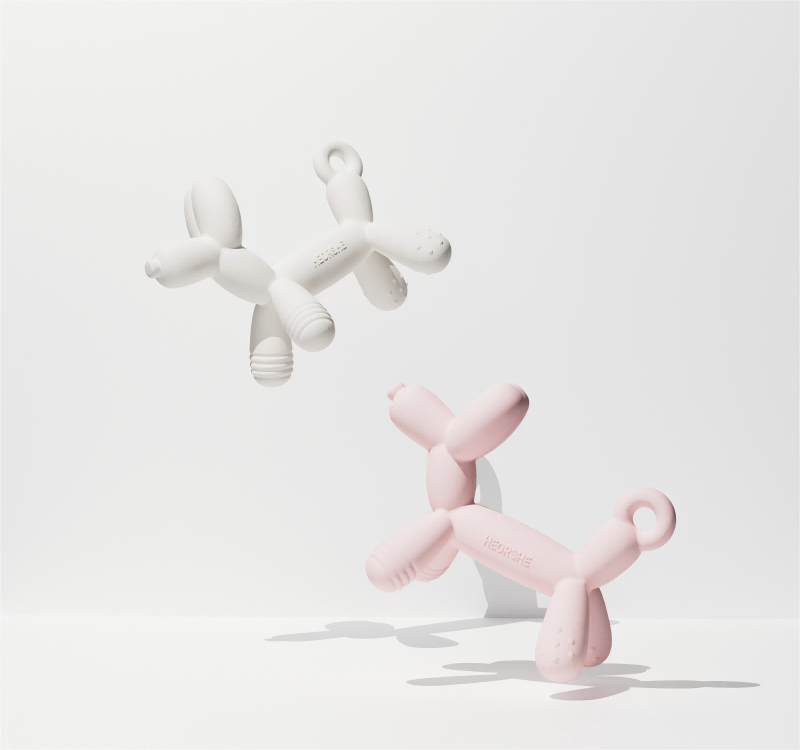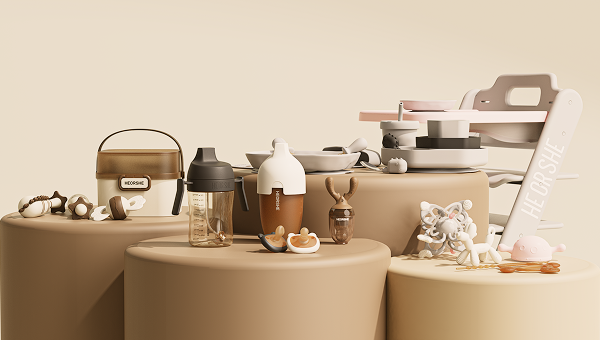Teething is one of the most memorable and often challenging milestones in your baby’s first year. From the moment the first tooth starts to push through the gums to the time your baby starts flashing that adorable toothy grin, teething can bring a wide range of symptoms and changes. As a parent, understanding baby teething, the signs of teething in babies, when do babies teeth, and how to manage baby grinding teeth can make a world of difference.
In this comprehensive guide, we’ll walk you through everything you need to know about baby teething. We’ll also introduce HEORSHE, a brand that offers innovative solutions to make teething smoother and more comfortable for your little one.
What Is Baby Teething?
Baby teething is the natural process in which an infant's first teeth, also known as primary or milk teeth, begin to emerge through the gums. This typically occurs in the first year of life, although the exact timing can vary significantly from one child to another.
Teething is a critical developmental milestone for babies. It marks the beginning of changes in nutrition, as babies move from a milk-only diet to one that includes solid foods. Teeth also play an essential role in speech development, allowing your child to articulate different sounds as they grow.
During this time, a baby's gums become sore and swollen as teeth push their way to the surface. This can lead to various physical and emotional symptoms, which is why it’s important for parents to be informed and prepared.

When Do Babies Teeth?
One of the most frequently asked questions by new parents is, "When do babies teeth?" Although there is a general timeline for tooth eruption, it can vary greatly. Some babies may start teething as early as 3 months, while others may not show any signs until after their first birthday.
Here is a general eruption schedule for baby teeth:
|
Tooth |
Average Age of Eruption |
|
Lower central incisors |
6–10 months |
|
Upper central incisors |
8–12 months |
|
Upper lateral incisors |
9–13 months |
|
Lower lateral incisors |
10–16 months |
|
First molars |
13–19 months |
|
Canines (cuspids) |
16–22 months |
|
Second molars |
23–33 months |
Most children will have a complete set of 20 primary teeth by the age of three. These teeth will eventually be replaced by permanent teeth during early adolescence.
Common Signs of Teething in Babies
Recognizing the signs of teething in babies can help you provide timely relief and comfort. While every baby is different, here are some common symptoms associated with teething:
- Excessive drooling: Increased saliva production can lead to drool rash on the cheeks, chin, and neck.
- Chewing on objects: Babies often gnaw on toys, fingers, or clothing to soothe the discomfort in their gums.
- Crankiness or irritability: The pressure of teeth pushing through the gums can make your baby fussier than usual.
- Red or swollen gums: Visibly inflamed gums are a clear indicator that a tooth is on its way.
- Sleep disruptions: The discomfort can make it hard for babies to fall or stay asleep.
- Loss of appetite: Sore gums can reduce a baby's desire to eat.
- Mild fever or rash: While not scientifically confirmed, some parents notice a low-grade fever or facial rash due to drooling.
- Ear pulling or cheek rubbing: This behavior can be a sign that your baby is feeling discomfort in the gums.
If symptoms include a high fever, diarrhea, or prolonged fussiness, consult a pediatrician as they may indicate a different health issue.
Baby Grinding Teeth – What Does It Mean?
One surprising behavior some parents observe during teething is baby grinding teeth, also known as bruxism. This can sound concerning, but it’s usually harmless and temporary.
Why do babies grind their teeth?
Exploration: Babies are often fascinated by the new sensation of teeth in their mouths and may grind out of curiosity.
Discomfort relief: Grinding may help soothe the discomfort caused by erupting teeth.
Stress or anxiety: While rare in infants, some older babies might grind teeth when they are overstimulated or anxious.
In most cases, teeth grinding stops on its own. However, if the habit continues or leads to noticeable tooth wear, it’s best to consult a pediatric dentist for guidance.
How HEORSHE Helps with Baby Teething
Managing teething symptoms is much easier when you have the right tools, and that’s where HEORSHE comes into the picture. Known for its baby-friendly designs and rigorous safety standards, HEORSHE offers products specifically made to support babies during the teething phase.
Key HEORSHE Products for Teething Relief:
1. HEORSHE Dental Care Teether
Made from 100% food-grade silicone
Textured surface massages the gums
Ergonomic shape easy for little hands to hold
2. HEORSHE Aqua Teething Mitten
Wearable design for babies who can’t grasp toys
Built-in crinkle sound stimulates sensory development
Soft silicone surface safe for chewing
3. HEORSHE Baby Training Toothbrush
Doubles as a gum massager and early dental hygiene tool
Soft silicone bristles are gentle on tender gums
Shaped for easy holding and maneuvering
4. HEORSHE Orthodontic Pacifier
BPA-free and ergonomically designed
Supports natural oral development
Provides comfort during teething naps and bedtime
Each product from HEORSHE is meticulously crafted to ensure safety, functionality, and aesthetic appeal. Parents can trust the brand to deliver thoughtful solutions for teething discomfort.

Safe and Effective Teething Remedies
In addition to HEORSHE's innovative solutions, several other remedies can ease teething discomfort:
A. Cold Therapy
Chilled items like a damp washcloth, cold spoon, or refrigerated (not frozen) teething ring can provide soothing relief.
B. Gentle Gum Massage
Using a clean finger, gently rub your baby's gums in circular motions. This helps reduce pain and improve circulation.
C. Teething Toys
Select BPA-free and textured teething toys. Silicone options are popular for their flexibility and ease of cleaning.
D. Comfort and Distraction
Cuddles, lullabies, and interactive playtime can distract babies from gum pain.
E. Medication (when necessary)
If discomfort is severe, consult your pediatrician about using infant acetaminophen or ibuprofen. Never use teething gels with benzocaine.
Tips for Managing Baby Teething with Ease
Coping with teething doesn’t have to be daunting. Here are some practical tips to make this phase smoother for both you and your baby:
Maintain Hygiene Clean your baby’s gums and emerging teeth daily using a soft damp cloth or baby toothbrush.
Use Bibs and Moisture Barriers Excessive drooling can cause rashes. Bibs and barrier creams can prevent skin irritation.
Create a Calming Bedtime Routine Try warm baths, baby massages, or lullabies to help your baby sleep better during teething.
Stay Consistent with Feeding If solid foods are uncomfortable, try soft, cool items like yogurt, mashed banana, or applesauce.
Choose Trusted Brands Rely on reputable names like HEORSHE that offer toxin-free, baby-safe products.
Frequently Asked Questions
Q1: When should I start brushing my baby’s teeth?
As soon as the first tooth erupts. Use a baby toothbrush and a rice-sized smear of fluoride toothpaste.
Q2: Is it normal for babies to grind their teeth?
Yes, it’s a common response to new sensations in the mouth. Most babies stop grinding as they get older.
Q3: Do babies get diarrhea from teething?
Teething itself doesn’t cause diarrhea, but some babies may have looser stools due to swallowing excess saliva.
Q4: What are HEORSHE teethers made from?
HEORSHE teethers are made from food-grade silicone and are BPA, PVC, and phthalate-free.
Q5: Can teething affect sleep?
Yes. Discomfort can disrupt normal sleep patterns, so it's important to maintain a soothing bedtime routine.
Conclusion
Teething is a major developmental milestone that comes with its unique set of challenges. By recognizing the signs of teething in babies, understanding when do babies teeth, and addressing issues like baby grinding teeth, parents can better support their child through this transition.
Brands like HEORSHE offer practical, beautifully designed products to ease discomfort and promote healthy oral development. By combining knowledge with the right tools, you can help your baby navigate the teething phase with comfort and confidence.
So cherish those little toothy grins — they’re a sign of growth, resilience, and a bright future ahead.


